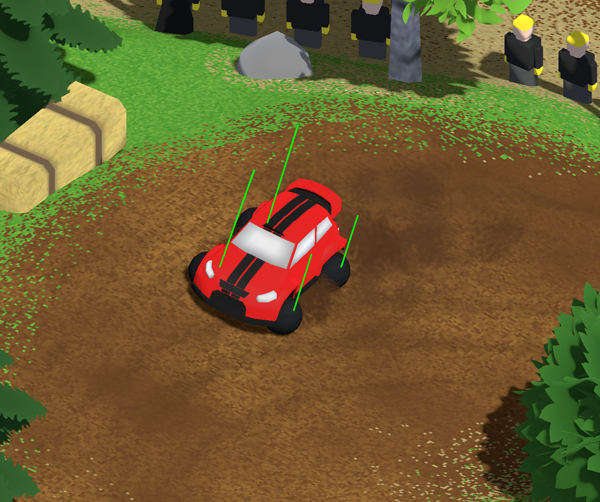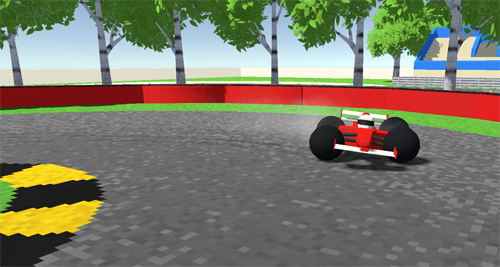Car Physics
- Development Update
In this blog post I will give an overview of our approach to modelling car physics in GeneRally 2. Here, as in other areas, our task is to build on GeneRally in a way that doesn’t undermine any of the features that made that game as enduringly popular as it has been.
Suspension and Steering
The largest difference to GeneRally 1 when it comes to car modelling is that GeneRally 2 models suspension in a more realistic fashion. This provides us with two potential benefits. Firstly, visually, it allows the cars to display realistic behaviour such as body roll under acceleration; wheels tracking uneven terrain; and suspension compressing when landing from jumps - this plays into our general push for a more lively and interesting world for the player to race in. Secondly, it provides a platform on which to build a more realistic handling model for the cars.
This second point, however, we have found to be a double-edged sword.
At an early stage of development we experimented with realistic steering behaviour and grip calculations, with traction calculated based on tire load and applied to turn the car by rotating the front wheels. This provided an improvement in realism, but it did not translate into improved gameplay. A realistic simulation of the tire forces often manifested simply as inconsistent or incomprehensible controls, due to the high downward camera angle making it very difficult for the player to see precisely what the car is doing at any given moment.
In the end we changed to implementing the steering the same way GeneRally 1 did: as a direct rotation of the car around its center of mass. Turning does not depend on immediate traction, or even on tire contact (to allow the car to turn happily in mid-air). This change means that the car will always react to steering inputs in a consistent manner.
Consistency is one of the keys to the kind of intuitive and easy-to-pick-up gameplay that we are going for. The handling model should be something the player doesn’t have to think about, since the car simply feels right. GeneRally, after all, doesn’t need to challenge the player with tricky handling - there is enough challenge in figuring out optimal lines; changing track conditions; and in planning your pit strategies over the course of a race or championship.
Improved Car Physics
But this doesn’t mean there won’t also be new and challenging cars in GeneRally 2!

The Rally car, showing its suspension forces.
Here is where a robust physics model gives greater opportunity for building interesting handling characteristics that can take some skill and experience to master. Adjusting tyre pressures or suspension parameters such as travel and damping coefficients, allows one to play with how planted/nervous a car feels on uneven terrain and how it transfers weight under braking and acceleration. Adjusting how tire load affects grip - and the relationship between static and dynamic friction - allows for varying understeer/oversteer characteristics and for cars that can be rotated with the brakes. The choice of driven wheels (FWD/RWD/AWD), differential type and torque also make a big difference to how a car performs.
Much of this car balancing remains to be done - and testing will show what can be done in a way that remains challenging in a fun, rewarding way. We’ve gathered a lot of valuable feedback about the physics and the Rally car during the period the demo has been available. Obviously, as GeneRally is not intended to be a simulation, there is no inherent value to doing things in a realistic way: if a more direct approach proves to be better for gameplay, that is what we’ll go for.
One such example is the demo’s Rally car: it includes an additional force that helps it to turn whilst sliding - a “slide assist” if you will. This feature was implemented as being able to throw the car into corners was deemed to be more fun than trying to avoid sliding to maintain grip. This makes going fast more about choosing the correct line and timing the turn-in, rather than about being able to precisely micromanage the car’s angle mid-corner.

Here’s the Formula showing a bit of body roll!
Car Selection
Questions about balancing realism with gameplay can, in this system, be done on a per-car basis - and in much more depth than was available in GeneRally 1. GeneRally 2 will include some cars that are made to be as easy to pick up as possible, and some cars that come with unique handling characterics to add variety and challenge for more experienced players. We will also make sure to have some throwbacks to the “classic GeneRally feel” for that healthy dose of nostalgia!
The full list of cars for Early Access release has not been set in stone yet - and it will certainly continue to grow over the Early Access period (and hopefully after the release too). In any case, you can expect the car selection in GeneRally 2 to be more varied in terms of their handling characteristics than in GeneRally 1.
In Closing
I hope you have enjoyed this peek into what goes into making of GeneRally 2’s cars. In future posts I’ll go into more detail about the workings of the car model and about the development of individual cars. You can also expect insights into the mysterious minds of the AI drivers.

